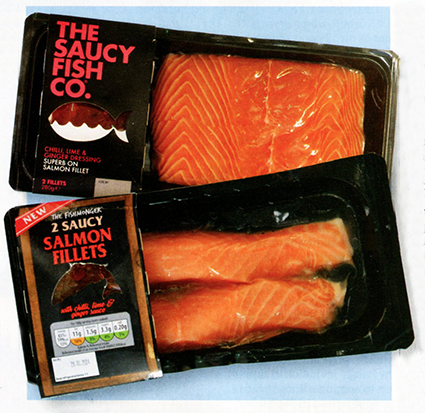
In this series of posts we take a look at key trends in food and drink, starting with a look at the rise of the own-label copy-cat.
The issue of copy-cat packaging has existed for many years but there seems to have been something of an avalanche of look-alikes recently with a number of big retailers being implicated. They say that imitation is the sincerest form of flattery but the lack of protection for brands in the UK means that some recent cases have bordered on outright plagiarism.
The burden of proof is on the brands to prove that the copy-cat is deliberately trying to make consumers think that it is the branded product (so called “passing off” rules), meaning that disputes between brands and retailers tend to be kept out of the public domain and are nearly always settled out of court.
That’s why we were surprised when we read the recent news about Seachill, the owners of the Saucy Fish Co brand taking legal action over Aldi’s “confusingly similar” salmon and sauce, but then when we saw the number of similarities between the two products it made the move a little more understandable; both feature black packaging and a cardboard sleeve with a fish shaped cutout on the left hand-side revealing a sachet of almost identical sauce.
In an interview with the Grocer last year, Aldi’s joint managing director Matthew Barnes said that he was impressed by the success of the Saucy Fish Co and spoke of plans for a similar offering – maybe a little too similar in this case.
Of course, there is nothing wrong with a retailer taking inspiration from a successful brand and they all do it to a lesser or greater extent; however there’s a fine line between an own-label product being “inspired” by a brand and being considered a blatant copy-cat.
Where is that line? Perhaps at the point where similarities are such that consumers feel that they have been duped into purchasing the own-brand product by mistake. According to this article in The Drum from last year, a fifth of the members of the consumer group Which? reported falling for that tactic.
Many have applauded Seachill’s move to fight their corner but there’s an interesting philosophical question to be asked; whilst Saucy Fish customers Tesco and Sainsbury’s recently launched their own fish-in sauce offering inspired by the brand (leading to a shock delisting then relisted by Tesco), would Seachill have risked the potential financial repercussions of taking the legal route if the aforementioned retailers had launched such strikingly similar offerings as Aldi’s saucy salmon?
Developing a packaging format that stands out on the shelf or in the chiller cabinet can take a lot of time and money, so we understand why brands get annoyed by own-label “me-too” versions that draw heavily on all that effort – here at IWP it frustrates us when elements of a packaging design we’ve created get “borrowed” to put it kindly. As far as resorting to litigation is concerned though, brands should think very carefully before taking the legal route because it’s hugely expensive, hugely risky and in the end it all depends on who is copying you.